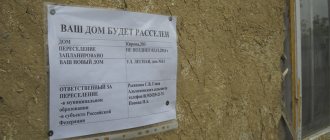What is “dilapidated housing”? Our house is dilapidated, as they explained to me, due to the fact that the wear of its structures is more than 70%, but there are no plans to demolish it yet. What is the difference between dilapidated housing and emergency housing? Can dilapidated housing be habitable?
Answer:
The concept of “dilapidated housing” is not defined in the legislation of the Russian Federation. Neither the Housing Code of the Russian Federation, nor the provision “On recognizing premises as residential premises, residential premises unsuitable for habitation and an apartment building as unsafe and subject to demolition or reconstruction”, approved by the Decree of the Government of the Russian Federation of January 28, 2006. No. 47 does not contain any mention of dilapidated housing. At the same time, this concept is widely used both in the names of various federal and local programs “for the regeneration of areas of dilapidated and dilapidated housing”, the resettlement of citizens from dilapidated and dilapidated housing, and is mentioned in judicial acts.
Dilapidated housing. Dilapidated condition of the building. Definition of the concept
The dilapidated condition of a building is a condition in which the structures, foundation (building as a whole), as a result of high physical wear and tear, no longer meet the specified operational requirements (“Methodological recommendations for protecting the rights of participants in the reconstruction of residential buildings of various forms of ownership” (approved by Order of the State Construction Committee of the Russian Federation dated November 10. 1998 N
The definition of the concept of “dilapidated condition of a building” is also contained in the Methodological manual for the maintenance and repair of housing stock MKD 2-04.2004 (approved by the State Construction Committee of Russia; not officially published).
In this manual, disrepair is defined as follows:
Dilapidated condition of a building is a condition in which the structure of the building and the building as a whole has wear and tear: for stone houses - over 70%, wooden houses with walls made of local materials, as well as attics - over 65%, the main load-bearing structures retain strength sufficient to ensure stability of the building, but the building no longer meets the specified operational requirements.
At the same time, the load-bearing structures of the building are building structures that form the building layout specified by the project, ensuring its spatial stability under calculated external influences.
Actual problems
The crisis in the construction industry has had a negative impact on the resettlement of citizens from dilapidated buildings. In addition, the number of such buildings is increasing dramatically.
Providing economical housing to citizens who are part of the vulnerable segment of the population (the majority of those living in unsuitable conditions belong to this category) is possible only with large government injections .
The main difficulty that arises in the process of solving the resettlement problem is the common opinion of officials regarding the amount of area provided in return . Some are guided by Art. 50 of the Housing Code of the Russian Federation, which states that each family member must live in a standard number of square meters, and others - Art. 89 of the Housing Code of the Russian Federation, which determines that the family must receive in return premises that are not inferior in size to the one occupied previously. Such disputes are possible only if we are talking about social rental housing, since the owner of a dilapidated apartment can only receive a similar number of square meters instead.
Emergency housing
Emergency condition of a building , according to the above-mentioned Methodological Manual MKD 2-04.2004, is a condition of a building in which more than half of the residential premises and the main load-bearing structures of the building (walls, foundations) are classified as emergency and pose a danger to the lives of residents.
At the same time, the emergency condition of the load-bearing structures of the building is the state of the load-bearing structures of the building, in which the structures or part of them, due to natural wear and tear and external influences, have excessive deformations and damage, have lost their design strength and, without strengthening measures taken, can cause an emergency condition of the residential premises or the entire residential premises buildings and pose a danger to residents.
A separate load-bearing structure of a building in the condition described above, if its collapse does not affect other structures or does not entail a change in living conditions or operation of the residential building as a whole, is considered pre-emergency.
It is not difficult to notice that if dilapidated housing (the dilapidated condition of a building) is characterized by a high degree of wear and tear of its structures without the danger of their collapse and, accordingly, does not pose a danger to life, then emergency housing has deformations and damage to load-bearing structures and living in this residential premises is life-threatening due to the real possibility of collapse.
Thus, the mere fact of deterioration of a building (above 70%) is not a sufficient basis for the conclusion that the building is in disrepair or unsuitable for habitation for other reasons. In addition, the legislation provides for the procedure for declaring residential premises unfit for habitation. According to paragraph 7 of the Regulations “On recognizing premises as residential premises, residential premises unsuitable for habitation and an apartment building as unsafe and subject to demolition or reconstruction”, approved by the Decree of the Government of the Russian Federation of January 28, 2006. No. 47, “Recognition of a premises as a residential premises suitable (unsuitable) for citizens to live in, as well as an apartment building as unsafe and subject to demolition or reconstruction, is carried out by an interdepartmental commission created for these purposes (hereinafter referred to as the commission), based on an assessment of the compliance of the specified premises and house with the established requirements in these Regulations. According to clause 42 of this provision, the Commission, on the basis of an application from the owner of the premises or an application from a citizen (tenant) or on the basis of the conclusion of bodies authorized to conduct state control and supervision on issues within their competence, assesses the compliance of the premises with those established in this Regulation requirements and recognizes the residential premises as suitable (unsuitable) for living, and also recognizes the apartment building as unsafe and subject to demolition or reconstruction.
○ Advice from a lawyer:
✔ Can you count on relocation from dilapidated housing?
The status of dilapidated and dilapidated housing is currently the same, and the first concept is included in the second. However, in some regional acts you can find similar names for houses. Many citizens also understand dilapidated housing as a building that is subject to reconstruction rather than demolition.
Regarding such housing, Art. 32 of the Housing Code of the Russian Federation provides for temporary resettlement in connection with the seizure of the land plot on which the house is located for state and municipal needs. During repair and restoration work, citizens are provided with apartments from the so-called maneuverable fund on a free basis.
Dilapidated housing is housing that is unfit for habitation. Arbitrage practice
In judicial practice, there is a position according to which dilapidated housing is, by definition, housing unsuitable for habitation. For example:
“..The legal concept of dilapidated housing is housing that is precisely unfit for habitation, which is confirmed by a number of legal documents” (Appeal ruling of the Supreme Court of the Republic of Bashkortostan dated May 27, 2014 in case No. 33-7217/14)
In another case, the court stated:
The argument of the appeal that, in accordance with the established procedure, according to the conclusion of 2011, the specified house was not recognized as unsafe, the judicial panel cannot recognize as justified, since the disputed house is included in the Program for the resettlement of citizens from dilapidated housing stock. In the Program, the concept of “dilapidated residential buildings” should include residential buildings classified as unsuitable for permanent residence on the basis of significant physical deterioration.
The procedure for recognizing residential premises as unfit for habitation is established by Decree of the Government of the Russian Federation of January 28, 2006 No. 47 “On approval of the Regulations on recognizing premises as residential premises, residential premises unsuitable for habitation and an apartment building as unsafe and subject to demolition or reconstruction” (Appeal ruling of the Supreme Court Republic of Bashkortostan dated November 29, 2012 in case No. 33-12732/2012).
Residents' rights
The Fund for Assistance to the Reform of Housing and Communal Services, created to provide comfortable and safe living conditions for citizens of the housing sector, provides mechanisms for the resettlement of residents of dilapidated buildings. The program is implemented by the highest regional executive body, and the necessary funds are allocated to local budgets in accordance with the law.
It is very important to know what problems residents can expect when moving out. According to current legislation, during resettlement, residents must be provided with appropriate housing in terms of amenities and square footage. Citizens applying for an increase in space are provided with an apartment taking into account the missing meters.
The provided property must have a kitchen stove and plumbing fixtures installed. Also a prerequisite is connection to all necessary engineering systems and communications:
- heating,
- Sewerage,
- Water supply,
- Electricity supply.
You should know that when moving into an emergency home:
- Residents are offered three options, but their individual wishes are not taken into account. Relocation to communal apartments is not carried out.
- New residential premises are provided in the area where the emergency building is located. Moving to another area is possible only with the consent of the residents.
- Owners of emergency apartments cannot enter into exchange agreements. It is also impossible to sell the apartment. Any such transaction is illegal.
- Local authorities allocate moving costs, but the necessary transport is allocated only once.
- If a citizen does not have a document certifying ownership, and he lives under a municipal rental agreement, then new housing is provided to him on the same terms.
All issues related to resettlement must be agreed in writing with the residents by government authorities. If any of the owners decides to receive compensation, then the redemption value of the housing recognized as unsafe is calculated.
Dilapidated housing under previous legislation
In the current housing legislation, as indicated above, there is no concept of dilapidated residential buildings, which is replaced by unfit for habitation.
Earlier, before the adoption of the Regulations “On recognizing premises as residential premises, residential premises unsuitable for habitation and an apartment building as unsafe and subject to demolition or reconstruction”, approved by the Decree of the Government of the Russian Federation of January 28, 2006. No. 47, the Regulation “On the procedure for recognizing residential buildings (residential premises) as unfit for habitation” was in force, approved by the Decree of the Government of the Russian Federation of September 4, 2003. No. 552. This Regulation contained the concept of “dilapidated condition of housing”.
Thus, according to clause 2 of the Regulations (approved by Resolution No. 552), residential buildings (residential premises) are considered unsuitable for living:
a) in dilapidated condition;
b) in disrepair;
c) in which the harmful effects of environmental factors have been identified.
According to clause 3 of the Regulations, the criteria and technical conditions for classifying residential buildings (residential premises) as dilapidated or in disrepair are approved by the State Committee of the Russian Federation for Construction and Housing and Communal Services.
How to challenge the commission's decision?
Let's face it: residents face a difficult task. You will have to run around the bureaucratic offices and personally study the regulatory framework of the issue.
Sometimes they initiate legal proceedings, since by hook or by crook the administration seeks to save its budget.
Important. Disputes arising with resettlement are resolved by the district court.
Judicial practice shows that the parties mainly dispute:
- inaction of the municipality after the applicants’ appeal;
- decisions of interdepartmental commissions regarding recognition of real estate as emergency, proposed measures;
- extended resettlement periods;
- unequal replacement or underestimation of the actual cost of housing when issuing compensation.
Payment of compensation
After a house is declared unsafe, local authorities must decide whether to provide the families living in it with other living space or financial compensation , the amount of which is determined by municipal specialists.
Market value is used to evaluate the property, and the transfer of money is carried out in accordance with the repurchase agreement. An owner who does not agree with the results can send a written notice to the administration with a request to carry out a review or file a statement of claim and submit everything to the court.
The rules for providing monetary compensation or other residential real estate in replacement of damaged property are described in the following video:
What year the house was built fits under dilapidated
Now no one deals with deadlines, people live and live, but there are no exact legal deadlines for each house.
This very reserve is 15 years. I asked: “And then. ". Answer: “then they will begin to fold up like houses of cards, because there is a concept - metal fatigue, and this is the weakest point in their design, because the houses are welded.”
I
What is dilapidated housing, how are houses recognized as such, and how does this affect residents?
The resettlement program provides: The municipality is obliged to provide housing with all the conditions necessary for normal living.
All systems must function in the house, and the footage of the apartments must correspond to the footage of the living quarters in the old house. Important: improvement of living conditions through such an exchange occurs only if legal requirements are met. For example, if the tenant is listed in the corresponding queue.
If a house is considered dilapidated but can be repaired, the municipality is obliged to provide residents with temporary housing.
Such residential premises usually contain a flexible fund, the apartments of which are initially intended for vulnerable categories of citizens.
[smartcontrol__shortcode key=”what is recognized as dilapidated housing” cnt=”1″ col=”1″ shls=”true”] [smartcontrol__shortcode key=”Dilapidated housing what is it” cnt=”1″ col=”1″ shls=” true"]
Reasons
Based on the current legislative norms, the following grounds can be identified that are sufficient to recognize a property as unsuitable for habitation and subject to liquidation:
- A large percentage of wear and tear on the house or its structural components.
- Violation of the integrity of the facility as a result of explosions, fires and other emergency situations.
- Changes in the sanitary parameters of the internal microclimate of the house, which creates a threat to the health and life of residents.
- The location of the property in an area where there is an increased risk of a man-made disaster.
- Placement of the building in close proximity to structures designed to transmit alternating current over a distance.
- Facility windows exit onto the highway with excess noise levels.
- The location of the property in a place with frequent occurrences of natural disasters that can have a destructive impact.
- A property cannot be recognized as unsafe on grounds if it can be eliminated by creating engineering structures or carrying out repair work.
In particular, housing cannot be considered unfit for habitation in the following cases:
- If there is no elevator in a five-story building, provided that it is not fully operational.
- In the absence of a hot water supply and sewerage system in 1- and 2-story buildings.
- In case of any discrepancies between the planned and actual living areas.
The recognition of housing as unsafe and unfit for habitation may not occur completely, but only partially.
Sometimes only a separate part of the house is considered dilapidated, for example, a separate living space due to the emergency condition of the interfloor ceiling.







